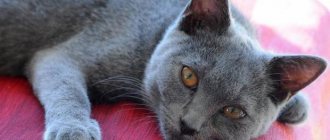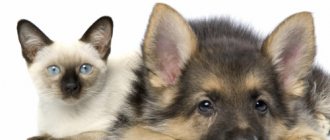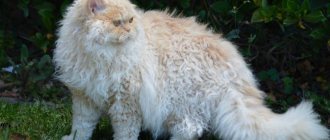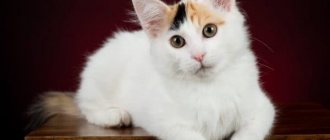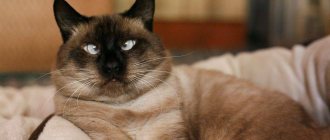What does "thoroughbred" mean?
When they say that a cat is purebred, they mean that it has a pedigree, which is an official document provided by the club. The club must be a member of one of the international organizations. A purebred cat meets a certain standard - it has generally accepted parameters (height, weight, appearance features, etc.) that are typical for the corresponding species. But it is subject to change periodically.
In addition to the main characteristics of the species that must be met, the standard describes disqualifying qualities. This is a list of flaws, both in appearance and in health, to which representatives of this breed are prone. The presence of disqualifying qualities listed in the standard does not give the right to individuals to take part in selection due to the high risks of genetic inheritance of defects by subsequent generations.
It's impossible to count
The main work of clubs and nurseries is to improve the cat's appearance, coat color, character, etc. In rare cases, they develop new breeds or color variations, but the last word, according to them, always lies with a large “cat” organization, which prescribes and sets the standard . The most prestigious are WCF, CFS, CFF, TICA and FIFe.
Each organization develops its own list, which includes a different number of breed names. Many cats are unlikely to boast a place on this list - it only contains selected purrs who have proven with their health, appearance, temperament and other qualities that they are valuable to the cat world.
It is very difficult to count the number of breeds - there is no fixed figure. It may be approved in one organization, but not in another.
After some time, the same breed may be excluded from the list or move to another category.
Another difficulty is the classification of the breed. For example, some organizations recognize the Himalayan cat separately, while others consider it a subspecies of Persian cats. Thus, everyone has their own system - one cat organization classifies mustachioed beauties by coat type, the second takes into account body type, and the third - origin. Therefore, to accurately answer the question - how many cat breeds can exist on the globe? - very hard.
The approximate number of mustachioed purrs to which the word “thoroughbred” can be applied ranges from 80 to 120 individuals, but subspecies should also be added to this number.
Breed defining organizations
The reason why it is not possible to count how many cat breeds there are in the world is the presence of 3 different organizations simultaneously engaged in felinological activities and approving breed standards:
- FIFe – is a member of the World Felinological Congress;
- TICA – Association with international status;
- WCF is the most revered in the world, its standards are the most demanding. The membership includes more than 500 clubs around the world.
Nuances of activity. The peculiarity of the work of these organizations is that they do not simultaneously recognize a new breed. The period of time during which all organizations confirm the development of a new breed can take several years. However, it also happens that a breed approved by one organization is not recognized by others, since the requirements in the standards may differ.
It is also impossible to count breeds because there are many enthusiastic collectors in the world who independently engage in breeding activities, crossing sometimes completely different, incompatible species. This is how new breeds appear, unrecognized by international organizations, but having the right to exist.
How many species of cats are there in the world?
It is not possible to count all the cats living on Earth, if only because they constantly reproduce and die. With long or short hair, large or small, with a round or wedge-shaped muzzle, with or without a tail - each variety includes an innumerable number of individuals. From the article we will find out how many cats there are in the world: wild, domestic and purebred.
- Wild cats
- Domestic (mongrel) cats
- Pedigree cats
- Standards
Wild cats
It is also impossible to determine how many cats are in the wild on planet Earth. Their representatives live on all continents except Antarctica. Some species have fully adapted to being close to humans.
Thus, the lynx totals about a million individuals in the world. But some cat populations are dying out before our eyes, despite constant offspring, and therefore it is difficult to say exactly how many cats there are on earth.
This is due to human activity and environmental degradation.
shutterstock
There is such data on endangered species.
- lion - currently lives less than 20 thousand;
- cheetah - less than 15 thousand;
- tiger - no more than 6 thousand;
- Asian leopard - approximately 100 individuals;
- snow leopard - a snow leopard with the most beautiful fur in the world - less than 100 individuals;
- white lion - several dozen.
Domestic (mongrel) cats
Studies have been conducted that have shown that over 400 million cats are kept at home. An adult cat gives birth to up to seven kittens at a time.
Not all owners limit the breeding of ordinary cats. Village pets regularly bear offspring about three times a year.
Only the reproduction of purebred individuals is constantly monitored, and therefore the number of cats in the world is difficult to accurately calculate.
The number of stray cats in populated areas around the world cannot be counted. Stray animals live near markets and warehouses, in the basements of residential buildings, and sometimes in garbage dumps.
Pedigree cats
Today there are quite a few cat breeds. These animals were first bred in Asia. Breeds have always been registered by International Phenological Universities. They also monitor the purity of the breed.
There are 40 breeds officially registered by the American Association. Of all domestic cats, only 3% are purebred.
What is meant by thoroughbred? First of all, specific exterior characteristics:
- unique color and pattern;
- presence or absence of wool and its type;
- length of body, tail and paws;
- weight;
- skull shape;
- structure of the ears;
- chest width;
- eye color type.
shutterstock
There are also secondary signs, for example, features and habits. It is possible to confirm that a cat is a representative of a particular breed only with the appropriate document. It is issued to every phenologically typical purebred animal. For cats, the supporting document is a pedigree, and for newborns, a certificate.
Standards
For each cat breed there are standards drawn up by the Association of Felinologists. The standard specifies all primary and secondary requirements and possible deficiencies. The standard explains which conformation characteristics are grounds for disqualification. The variety of breeds is great.
There are a large number of wool types alone:
- shorthair: Thai cat, British cat and many others;
- long-haired: Persian cat, Siberian and others;
- hairless cats: Donskaya, St. Petersburg and Canadian Sphynx, Ukrainian Levkoy.
Take as the basis for the classification of cats and sizes:
- small, weighing within four kilograms: toy bob, balinese, minskin and others;
- large (up to 15 kg): bob-tails, Maine Coon, Turkish Van, Chausie, Siberian, Norwegian Forest.
In all countries of the world, clubs require owners of purebred animals to approve each mating, as they monitor their frequency. Pre-registration is required for expensive cats, although not everyone can afford them. Mating of these cat breeds is not carried out just like that, without an order.
Unfortunately, even the World Cat Congress does not name the exact number of purebred cats. After all, each individual Association and each club maintains its own records of purebred cats, and the number of cats on the list of one organization may not coincide with the list of another. So, from the article the reader learned that there are approximately 40 breeds of cats in the world and they are all different in standards and classification.
How are breeds classified?
Each organization has its own characteristics and takes into account certain parameters. The most commonly used:
- body shape, proportions;
- health characteristics, tendency to certain diseases;
- character and temperament traits;
- characteristics of wool, its length and color.
The most numerous organization for cat breeds is the WCF organization. According to its data, there are 74 species, in FIFe - 51 and in TICA - 73.
Main criteria
The breeds presented below are generally recognized by all organizations.
Features of wool
Depending on the length of the coat there are:
- long-haired (coat length about 15 cm) - this group includes Persians, Burmese and Siberians;
- shorthaired - Egyptian, Chartreuse, blue;
- with curly or kinky hair - German and Cornish Rex;
- wire-haired - American;
- hairless - sphinx, bambino.
Color
In addition to the length of the coat, color is also important:
- tortoiseshell – Persians, bobtail;
- spotted - chinchilla, American with short fur;
- single color - Havana and Korat;
- two-color – ragdoll, Norwegian forest;
- motley - angora.
Drawing
In addition to the color of the fur coat, which can combine several colors, types are distinguished according to the type of pattern:
- solid – gray, black, red;
- zonal – spotted, striped;
- white – representatives of this species have a white color with spots of various colors and shades on the coat;
- silver – smoky, cameo;
- color point - the body is darker in color, and the paws are slightly lighter.
Body features and body shape
This parameter divides all breeds into 6 types:
- Stocky or cobby . The most prominent representatives of the species are exotics and manxes. Their legs are short, their neck is shortened, and their sternum is widened.
- Heavy breeds with a powerful body . These are Maine Coons, Siberians. Individuals have massive paws, a short neck, and their tail is also distinguished by its power.
- Semi-foreign - this group includes the Russian Blue and the American Longhair. This type is the most common. Representatives of the species have average body parameters.
- Semi-cobby - British Shorthair. Outwardly, the individuals are similar to semi-foreign cats, but they are a little stockier.
- Oriental view . Representatives: Siamese, Balinese. Oriental cats are characterized by a graceful, elegant physique, the tail and paws are long, the muzzle has a narrowed shape at the nose.
- Foreign - Abyssinians. Cats are distinguished by an elongated tail, a wedge-shaped head, and pronounced muscles. The ears are elongated, but this feature is not mandatory.
These parameters are considered the main ones for dividing all representatives of the cat world into separate species.



